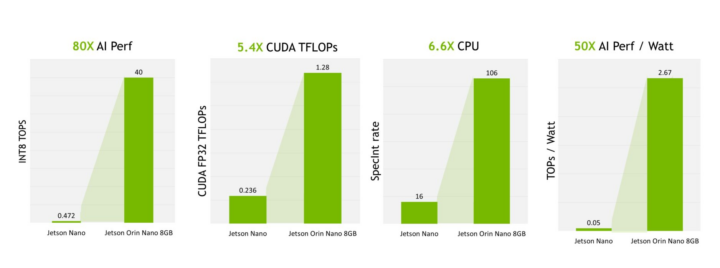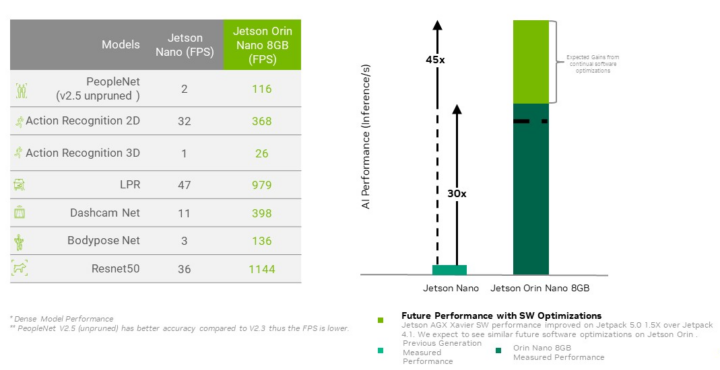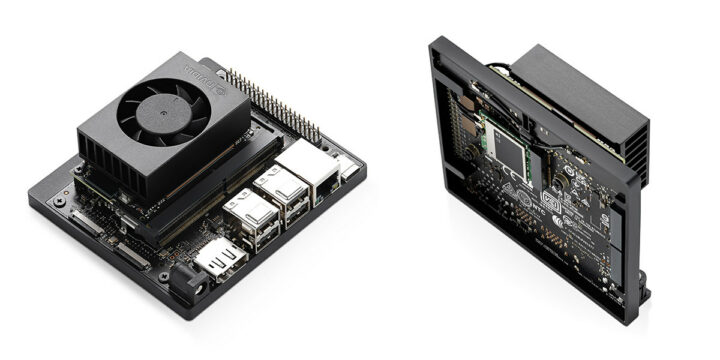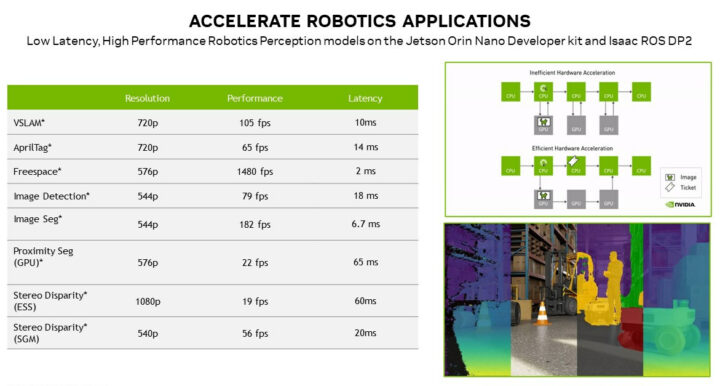NVIDIA Jetson Orin Nano Developer Kit is an upgrade to the popular Jetson Nano Developer Kit that delivers 80 times the performance, up to 50 times the performance per watt, and gives the developers the ability to design entry-level AI-powered robots, smart drones, intelligent vision systems, and more.
The Jetson Orin Nano has a similar form factor as the original Jetson Nano, but is fitted with a Jetson Orin Nano 8GB module with up to 40 TOPS AI performance, and is equipped with a DisplayPort video output, USB 3.2 Gen 2 ports, two M.2 Key M sockets for SSDs, Gigabit Ethernet, a pre-installed Wi-Fi module, and connectors for cameras.
NVIDIA Jetson Orin Nano Developer Kit specifications (compared to Jetson Nano Developer Kit-B01)
| Jetson Nano Developer Kit-B01 | Jetson Orin Nano Developer Kit | |
|---|---|---|
| CPU | Quad-core Arm A57 @ 1.43 GHz | 6-core Arm Cortex-A78AE v8.2 64-bit CPU @ 1.5 GHz with 1.5 MB L2 + 4 MB L3 |
| GPU | 128-core Maxwell GPU | 1024-core Ampere GPU |
| AI accel. | N/A | 32 Tensor Cores |
| Memory | 4 GB 64-bit LPDDR4 @ 25.6 GB/s | 8 GB 128-bit LPDDR5 @ 68 GB/s |
| Storage | MicroSD slot | MicroSD slot M.2 Key M socket for NVMe SSD |
| Video Output | HDMI 2.0 and eDP 1.4 (video only) | DisplayPort 1.2 (+MST) |
| Camera I/F | 2x MIPI CSI-2 |
|
| Video Decode | 4K60 | 2x 4K30 | 8x 1080p30 | 18x 720p30 H.264/H.265) | 4K60 | 2x 4K30 | 5x 1080p60 | 11x 1080p30 (H.265) |
| Video Encode | 4K @ 30 | 4x 1080p @ 30 | 9x 720p @ 30 (H.264/H.265) | 1080p30 supported by 1-2 CPU cores (i.e. software encoding) |
| Networking | Gigabit Ethernet |
|
| USB | 4x USB 3.0 1x Micro USB 2.0 device | 4x USB 3.2 Gen2 1x USB-C device (also used for debugging) |
| Expansion | M.2 Key E socket (PCIe x1, USB 2.0, UART, I2S, and I2C) 40-pin expansion header with GPIO, I2C, I2S, SPI, UART signals | M.2 Key E socket (PCIe x1, USB 2.0, UART, I2S, and I2C) 40-pin expansion header with GPIO, I2C, I2S, SPI, UART signals M.2 Key M socket (PCIe Gen3 x4) M.2 Key M socket (PCIe Gen3 x2) |
| Power Supply | 5V/4A via power barrel 5V/2A via micro USB optional PoE support | 9-20 V (19V supply provided) via DC jack Optional PoE and back power headers |
| Power Modes | 5-10W | 7-15W |
| Cooling | Heatsink | Heatink + fan |
| Dimensions | 100 x 80 x 26 mm | 100 x 79 x 21 mm |
| Price | $99 | $499 |
| AI Performance | 0.5 TOPS (FP16) | 40 Sparse TOPS | 20 Dense TOPS |


The new developer kit is supported by the Ubuntu 20.04-based NVIDIA JetPack 5.1.1 SDK, as well as application-specific frameworks such as NVIDIA Isaac ROS and DeepStream, which are also integrated with cloud-based frameworks like Isaac Sim on Omniverse and NVIDIA Metropolis, and the NVIDIA TAO Toolkit with pre-trained AI models.
NVIDIA also shared AI benchmarks specific to robotics applications with the Jetson Orin Nano devkit running Isaac ROS Developer Preview 2 (DP2) based on ROS 2 robotics framework:
- Visual SLAM enables a robot to compute its location and movement from images by tracking visual features around its environment
- April Tags for AprilTag detection and pose estimation
- Image Detection
- Image Segmentation
- Proximity Segmentation to determine whether an obstacle is within a proximity field and to avoid collisions with obstacles during navigation
- Stereo Disparity for taking stereo input images and generating a disparity map of the input image for robot navigation
Most of those tasks would probably not run with a high enough FPS and low enough latency on the original Jetson Nano devkit, but the Jetson Orin Nano Developer Kit handles most of those in real-time with minimal latency.
Leela Karumbunathan, hardware product manager at NVIDIA, has done a very good job with the Getting Started video below, describing the hardware and software, showing how to get up and running with the board, and showcasing some demos such as City Segmentation for segmenting urban cityscapes into different classes and PeopleNet Transformer in less than 5 minutes. I guess it’s what happens when you let engineers make a video about their devkit instead of the marketing department…
The NVIDIA Jetson Orin Nano Developer Kit is available for pre-order on Seeed Studio or Sparkfun for under $500 with deliveries expected to start in April. More details may be found in the announcement, developer blog, and product page.

Jean-Luc started CNX Software in 2010 as a part-time endeavor, before quitting his job as a software engineering manager, and starting to write daily news, and reviews full time later in 2011.
Support CNX Software! Donate via cryptocurrencies, become a Patron on Patreon, or purchase goods on Amazon or Aliexpress








The main complaints I’ve seen are the price, the amount of RAM, and the usual Arm desktop problems (see Tom’s Hardware review).
The price may be tolerable if you know what you’re using it for. An alternate option is to pick up an RTX A2000 ($250?) or other Ampere card.
This isnt the same as a GPU. You would not buy this to use in AI training in your home with power. You use these SBCs to be able to run a trained AI model embedded to something, like a car
Bingo! Someone that gets it.
It amazes when people periodically think they can get things like a training workstation on the cheap or anything other than a bespoke overpriced Beast Mode set top box (And know going into it and not bitch about, “price’).
Whines of, “more RAM,” and the like belie an abject ignorance of what this stuff is mostly about…
An Ampere card ISN’T something you use for Autonomous Vehicles or things like AI cams. TOO much power and thermal profile.
It’s NOT intended for desktop use, either. It’s not upgradeable even in the ways a NUC or similar is.
40 TOPS for an edge AI engine for $500 or so is actually cheap, to be bluntly honest with you.
People rather need to understand what all, “embedded board,” means and know that this means, that for MANY, most of this isn’t going to be for them when it graces this discussion list. Suggestions of DESKTOP or SERVER solutions are a bit gratuitous, to be honest…
“The main complaints I’ve seen are the price”
depends on part of global economy POV (performance: comparison(&explanation on calculation optimizations) between Ampere (1024 CUDA cores) and e.g. ARM Armv9 Valhall GPU (1-16 shader cores) and Ethos ~N77 NPU (~5TOPS/W) available?)
What is the operating temp grades of this jetson kit?
One would presume it’s similar to the NX…
The temperature range of the kit is 0 to 35C.